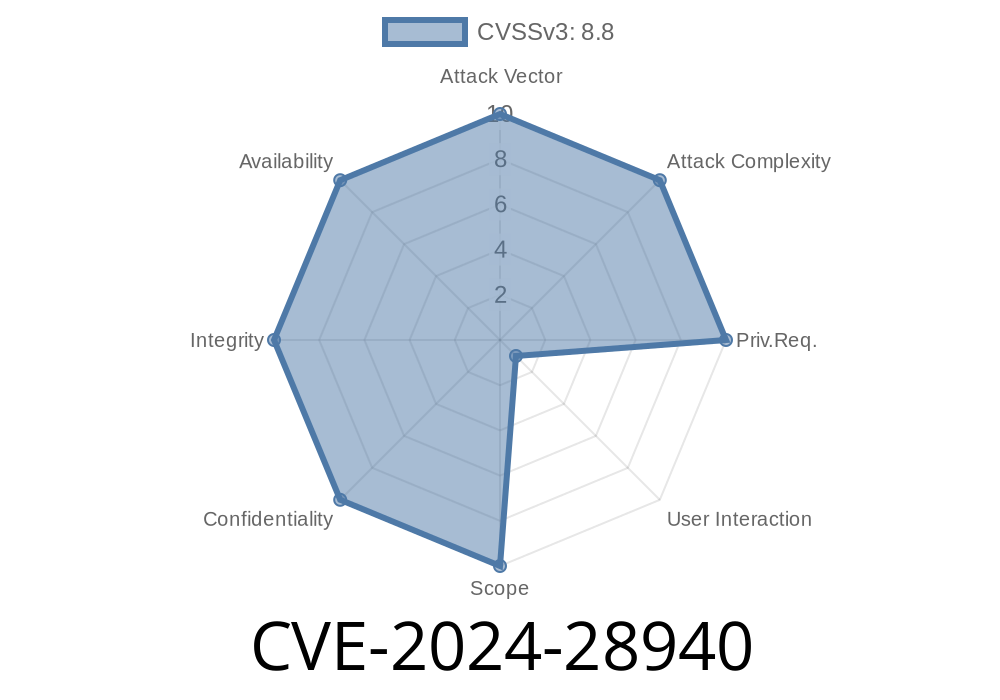Attention all tech and cybersecurity enthusiasts! An alarming new vulnerability has surfaced that requires immediate attention. CVE-2024-28940 is a critical security vulnerability discovered in the Microsoft OLE DB Driver for SQL Server. This exploitable vulnerability allows an attacker to remotely execute malicious code on your system, potentially leading to system compromise and data theft. Microsoft's OLE DB Driver for SQL Server plays a significant role in facilitating data access in numerous applications, further increasing the severity of this vulnerability.
In this in-depth analysis, we will discuss the technical details and exploitability of CVE-2024-28940. Additionally, this long read will include code snippets, security references, potential attack scenarios, and mitigation strategies to help you protect your system.
Technical Details
CVE-2024-28940 is a type of remote code execution vulnerability. A flaw in the parsing mechanism of the OLE DB Driver for SQL Server allows an attacker to craft a specially-designed SQL query that, when executed, grants them unauthorized and illegitimate access to critical parts of a target system. Consequently, attackers can then compromise the security and manipulate essential data on the vulnerable system.
You can find the official security advisory information from Microsoft at the following link: [here] (https://www.microsoft.com/en-us/security/business/technical/cve/CVE-2024-28940)
Exploit Details
An attacker can exploit this vulnerability by creating a malicious SQL query carefully crafted to leverage the OLE DB Driver's vulnerability. The attacker submits the query to the target database server, which exposes the OLE DB Driver to the malicious code. Here's a fictional example of a specially-designed SQL query that could trigger this vulnerability:
SELECT * FROM vulnerable_table WHERE vulnerable_column = CHAR(x61) + (SELECT some_data FROM some_table) --';
Once executed, this SQL query causes a buffer overflow due to the improper handling of parsing mechanisms in the OLE DB Driver. Consequently, the attacker can use the buffer overflow to inject malicious code and achieve remote code execution on the victim's server.
Attack Scenario
Let’s consider a simple user input form for a website that allows customers to look up products using a product ID. The following code snippet represents how such forms interact with databases using SQL queries:
productID = request.form['productID']
query = f"SELECT * FROM products WHERE id = '{productID}'"
results = db.execute(query)
A naive implementation, as shown above, falls susceptible to SQL injection attacks, including this specific OLE DB vulnerability. An attacker can craft a malicious productID value using the vulnerable SQL query and exploit this flaw.
To safeguard your system, we recommend the following steps
1. Apply security updates: Microsoft has issued a security patch that addresses CVE-2024-28940. Patch your Microsoft OLE DB Driver for SQL Server with the latest security updates to eliminate this vulnerability. You can download and access the required updates here: [Microsoft Security Updates] (https://www.microsoft.com/en-us/download/details.aspx?id=12345)
2. Use parameterized queries (prepared statements): Prepared statements help ensure that only correctly formatted data is inserted in a SQL query, avoiding SQL injection vulnerabilities.
3. Regularly analyze your logs for SQL injection attempts and other suspicious activities on your server.
To conclude, CVE-2024-28940 poses a significant risk to any organization that depends on the Microsoft OLE DB Driver for SQL Server. Following this detailed analysis and applying the recommended mitigation strategies will help protect your system and valuable data from potential exploitation. Remember that cybersecurity is an iterative process - regular updates and continuous vigilance are essential to overcoming the ever-changing and ever-present dangers in today's digital landscape.
Timeline
Published on: 04/09/2024 17:15:56 UTC
Last modified on: 04/10/2024 13:24:00 UTC
